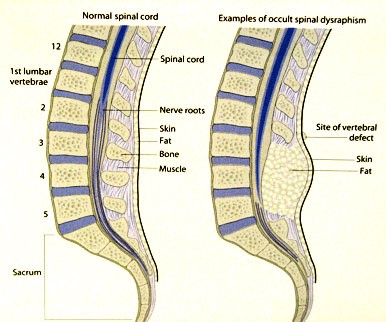Sporadic. Neurological syndrome due to a congenital defect in which the lower end of the spinal cord is attached at the bottom of the vertebral column: consequently, the spinal cord cannot adapt to the growth in length of the spine and stretching results, leadind to progressive neural damage with difficulties for walking and bladder and bowel control problems.
Embryological reminder: on the 3rd month of gestation, the spinal cord extends over almost the entire length of the spine; afterwards the spine is growing faster than the spinal cord. In the newborn, the lower end of the spinal cord is located around the L2 - L3 vertebra level, while in adults it is located next to L1 lumbar vertebra.
The possible causes of tethered spinal cord are:
• a thickened filum terminale
• the presence of a lipoma (intradural lipoma, intramedullary lipoma, lipomyelomeningocele or lipoma of the filum terminale) (see figure)
• a spinal malformation: diastematomyelia, or in the context of a VACTERL syndrome
• postoperative scars (relapse/onset after surgery), and after surgery for spina bifida.

Clinical signs: presence of a presacral or lumbar mass, sacral dimple, angioma, tuft of hair at the level of the neuraxis; trouble of walking; sphincter disorders; sometimes: scoliosis.
Diagnosis: echography in the newborn, spinal MRI
Treatment: release of spinal cord via a posterior route (mini-laminectomy) to resect the lipoma, cut the filum terminale or free scar adhesions.
Anesthetic implications:
neuraxial block is contraindicated; surgery for tethered spinal cord is delicate (ventral decubitus) and requires a peroperative monitoring of nerve conduction and intraoperative electromyography (any myorelaxant is to be avoided)
References :
- O'Neill BR, Yu AK, Tyler-Kabara EC.
Prevalence of tethered spinal cord in infants with VACTERL.
J Neurosurg Pediatr 2010; 6:177-82.
- Lew SM, Kothbauer KF.
Tethered cord syndrome: an updated review.
Pediatr Neurosurg 2007; 43:236-48.
- Phillips LH 2nd, Jane JA.
Electrophysiologic monitoring during tethered spinal cord release.
Clin Neurosurg 1996; 43:163-74.
Updated: February 2017